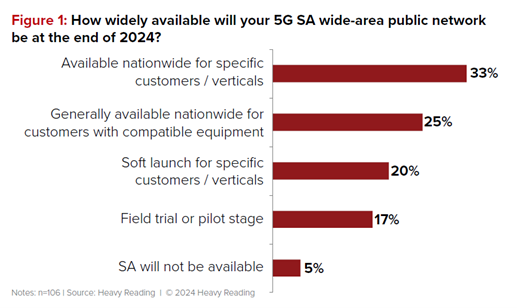5G SA hits its stride in 2024
5G standalone has been taking a while, but it's critical to industry growth and renewal, writes Heavy Reading analyst Gabriel Brown, whose new 5G network operator survey is out now.

5G standalone (SA) will hit its stride in 2024 and scale globally from 2025 onward, says the new Heavy Reading 5G Network Strategies Operator Survey.
The SA architecture, which refers to a 5G RAN connected to a 5G core network, is critical to the evolution of the 5G ecosystem. SA introduces an array of new capabilities that operators can use to deliver a wider, richer set of services and is a prerequisite for 5G Advanced.
Leading operators are already live at scale with SA — most notably, T-Mobile in the US and Reliance Jio in India (and several Chinese operators, which are not represented in the survey). However, in the wider market, SA is still in the development and launch phases.
As shown in Figure 1 below, according to the Heavy Reading survey, 25% of respondents believe their company's wide-area SA network will be "generally available nationwide to customers with compatible equipment" by the end of 2024.
"Compatible equipment" is the key phrase in this question because end users must have an SA-capable device with the SA features activated. Today, this generally means a higher end Samsung or Apple smartphone. Typically, operators launch SA with Samsung or another Android brand while they wait for approval from Apple.
A further 33% of respondents say SA will be available nationwide for specific customers / verticals by the end of 2024. 20% are in the soft launch phase, and 17% are in the field trial or pilot phase. Just 5% don't expect any wide-area SA activity this year.
This survey data, taken together with news flow and direct conversations with operators, gives Heavy Reading the confidence to declare that the mobile industry is now on the threshold of large-scale SA adoption. We can think of widespread SA as a form of critical mass that will drive the evolution of 5G networks and services through the rest of the decade.

5G SA is long-term play
To get to this point, the industry has had to make vast investments in R&D, product development, spectrum and network buildout. For a successful SA deployment, an operator needs a well-engineered 5G RAN with coverage commensurate with 4G, a 5G core network (typically deployed on a network cloud infrastructure platform) and a sufficiently large proportion of SA-capable devices in its subscriber base. (For an analysis of why this is hard, see my 2022 article: "Why is 5G SA taking so long?")
Once SA is in place, the challenge is to turn new capabilities into compelling consumer and enterprise services. These capabilities include network slicing, an architecture better suited to edge services, network APIs, a new QoS model, enhanced security and encryption, support for "RedCap" IoT devices, enhanced uplink, lower latency and more. A cloud native production environment, based around CI/CD principles and greater automation of the network service lifecycle, enables operators to make best use of SA features.
In the medium term, the entire set of 5G Advanced capabilities also depends on SA.
But creating a service portfolio based on SA capabilities will not be an easy or quick process. SA is not a "silver bullet" that will turn the 5G monetization challenge around overnight. On an industrywide basis, SA is a long-term transition. Even once SA is available, new capabilities will be introduced and scaled in phases as technology and market demand allow.
Without SA, however, operators are limited to 5G non-standalone (NSA) and a service portfolio that can be supported in a 4G architecture. Progress would effectively be blocked.
SA is a necessary and long-planned upgrade to 5G networks that has the potential to diversify and enhance 5G network services over the medium term. It is critical to industry growth and renewal. And at Heavy Reading, we're now confident it is coming soon to network near you.
To download a copy of the full 5G Network Strategies Operator Survey (6th edition), click here.
About the Author(s)
You May Also Like




_International_Software_Products.jpeg?width=300&auto=webp&quality=80&disable=upscale)







